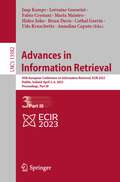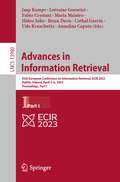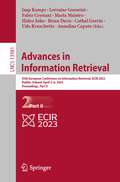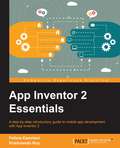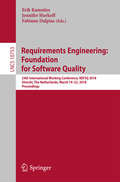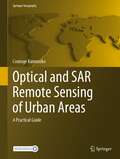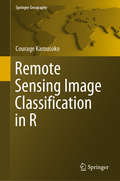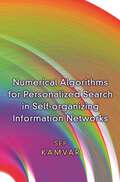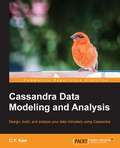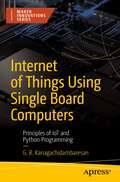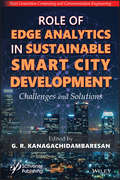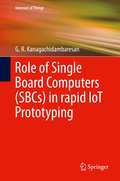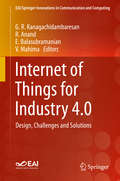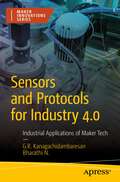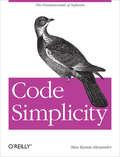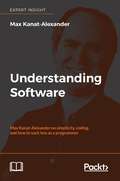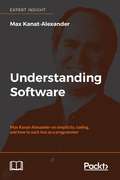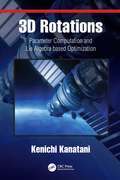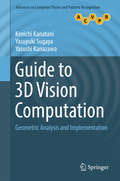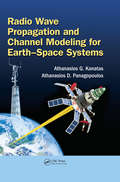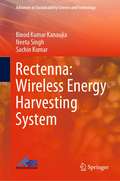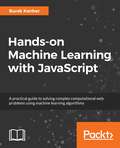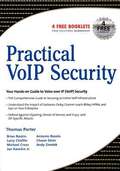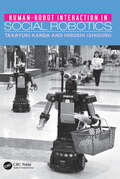- Table View
- List View
Advances in Information Retrieval: 45th European Conference on Information Retrieval, ECIR 2023, Dublin, Ireland, April 2–6, 2023, Proceedings, Part III (Lecture Notes in Computer Science #13982)
by Jaap Kamps Lorraine Goeuriot Fabio Crestani Maria Maistro Hideo Joho Brian Davis Cathal Gurrin Udo Kruschwitz Annalina CaputoThe three-volume set LNCS 13980, 13981 and 13982 constitutes the refereed proceedings of the 45th European Conference on IR Research, ECIR 2023, held in Dublin, Ireland, during April 2-6, 2023. The 65 full papers, 41 short papers, 19 demonstration papers, 12 reproducibility papers consortium papers, 7 tutorial papers, and 10 doctorial consortium papers were carefully reviewed and selected from 489 submissions. The book also contains, 8 workshop summaries and 13 CLEF Lab descriptions. The accepted papers cover the state of the art in information retrieval focusing on user aspects, system and foundational aspects, machine learning, applications, evaluation, new social and technical challenges, and other topics of direct or indirect relevance to search.
Advances in Information Retrieval: 45th European Conference on Information Retrieval, ECIR 2023, Dublin, Ireland, April 2–6, 2023, Proceedings, Part I (Lecture Notes in Computer Science #13980)
by Jaap Kamps Lorraine Goeuriot Fabio Crestani Maria Maistro Hideo Joho Brian Davis Cathal Gurrin Udo Kruschwitz Annalina CaputoThe three-volume set LNCS 13980, 13981 and 13982 constitutes the refereed proceedings of the 45th European Conference on IR Research, ECIR 2023, held in Dublin, Ireland, during April 2-6, 2023. The 65 full papers, 41 short papers, 19 demonstration papers, and 12 reproducibility papers, 10 doctoral consortium papers were carefully reviewed and selected from 489 submissions. The accepted papers cover the state of the art in information retrieval focusing on user aspects, system and foundational aspects, machine learning, applications, evaluation, new social and technical challenges, and other topics of direct or indirect relevance to search.
Advances in Information Retrieval: 45th European Conference on Information Retrieval, ECIR 2023, Dublin, Ireland, April 2–6, 2023, Proceedings, Part II (Lecture Notes in Computer Science #13981)
by Jaap Kamps Lorraine Goeuriot Fabio Crestani Maria Maistro Hideo Joho Brian Davis Cathal Gurrin Udo Kruschwitz Annalina CaputoThe three-volume set LNCS 13980, 13981 and 13982 constitutes the refereed proceedings of the 45th European Conference on IR Research, ECIR 2023, held in Dublin, Ireland, during April 2-6, 2023. The 65 full papers, 41 short papers, 19 demonstration papers, 12 reproducibility papers consortium papers, 7 tutorial papers, and 10 doctorial consortium papers were carefully reviewed and selected from 489 submissions. The book also contains, 8 workshop summaries and 13 CLEF Lab descriptions. The accepted papers cover the state of the art in information retrieval focusing on user aspects, system and foundational aspects, machine learning, applications, evaluation, new social and technical challenges, and other topics of direct or indirect relevance to search.
The Indian Periodical Press and the Production of Nationalist Rhetoric
by Sukeshi KamraConsiders the Indian periodical press as a key forum for the production of nationalist rhetoric. It argues that between the 1870s and 1910, the press was the place in which the notion of 'the public' circulated and where an expansive middle class, and even larger reading audience, was persuaded into believing it had force.
App Inventor 2 Essentials
by Felicia Kamriani Krishnendu RoyA step-by-step introductory guide to mobile app development with App Inventor 2 About This Book * Get an introduction to the functionalities of App Inventor 2 and use it to unleash your creativity * Learn to navigate the App Inventor platform, develop basic coding skills and become familiar with a blocks based programming language * Build your very first mobile app and feel proud of your accomplishment * Follow tutorials to expand your app development skills Who This Book Is For App Inventor 2 Essentials is for anyone who wants to learn to make mobile apps for Android devices - no prior coding experience is necessary. What You Will Learn * Perform technical setup and navigate the App Inventor platform * Utilize the interactive development environment by pairing a mobile device with a computer using Wi-Fi or USB * Build three apps: a game, an event app and a raffle app * Create the user interface of the app in the Designer and program the code in the Blocks Editor * Integrate basic computer science principles along with more complex elements such fusion tables and lists * Test and troubleshoot your applications * Publish your apps on Google Play Store to reach a wide audience * Unleash your creativity for further app development In Detail App Inventor 2 will take you on a journey of mobile app development. We begin by introducing you to the functionalities of App Inventor and giving you an idea about the types of apps you can develop using it. We walk you through the technical set up so you can take advantage of the interactive development environment (live testing). You will get hands-on, practical experience building three different apps using tutorials. Along the way, you will learn computer science principles as well as tips to help you prepare for the creative process of building an app from scratch. By the end of the journey, you will learn how to package an app and deploy it to app markets. App Inventor 2 Essentials prepares you to amass a resource of skills, knowledge and experience to become a mobile app developer Style and approach Every topic in this book is explained in step-by-step and easy-to-follow fashion, accompanied with screenshots of the interface that will make it easier for you to understand the processes.
Requirements Engineering: 24th International Working Conference, Refsq 2018, Utrecht, The Netherlands, March 19-22, 2018, Proceedings (Lecture Notes in Computer Science #10753)
by Erik Kamsties Jennifer Horkoff Fabiano DalpiazThis book constitutes the proceedings of the 24th International Working Conference on Requirements Engineering - Foundation for Software Quality, REFSQ 2018, held in Utrecht, The Netherlands, in March 2018. The 23 full and 2 invited talks papers presented in this volume were carefully reviewed and selected from 57 submissions. The papers were organized in topical sections named: RE in Industrial Practice; NLP in Theory and Practice; Empirical Insights into Traceability; Taming Ambiguity; Large-Scale RE; Quality Requirements; User and Job Stories; Requirements Alignment; RE Previews and Visions; Big Data; Mindmapping and Requirements Modeling.
Optical and SAR Remote Sensing of Urban Areas: A Practical Guide (Springer Geography)
by Courage KamusokoThis book introduces remotely sensed image processing for urban areas using optical and synthetic aperture radar (SAR) data and assists students, researchers, and remote sensing practitioners who are interested in land cover mapping using such data. There are many introductory and advanced books on optical and SAR remote sensing image processing, but most of them do not serve as good practical guides. However, this book is designed as a practical guide and a hands-on workbook, where users can explore data and methods to improve their land cover mapping skills for urban areas. Although there are many freely available earth observation data, the focus is on land cover mapping using Sentinel-1 C-band SAR and Sentinel-2 data. All remotely sensed image processing and classification procedures are based on open-source software applications such QGIS and R as well as cloud-based platforms such as Google Earth Engine (GEE). The book is organized into six chapters. Chapter 1 introduces geospatial machine learning, and Chapter 2 covers exploratory image analysis and transformation. Chapters 3 and 4 focus on mapping urban land cover using multi-seasonal Sentinel-2 imagery and multi-seasonal Sentinel-1 imagery, respectively. Chapter 5 discusses mapping urban land cover using multi-seasonal Sentinel-1 and Sentinel-2 imagery as well as other derived data such as spectral and texture indices. Chapter 6 concludes the book with land cover classification accuracy assessment.
Remote Sensing Image Classification in R (Springer Geography)
by Courage KamusokoThis book offers an introduction to remotely sensed image processing and classification in R using machine learning algorithms. It also provides a concise and practical reference tutorial, which equips readers to immediately start using the software platform and R packages for image processing and classification. This book is divided into five chapters. Chapter 1 introduces remote sensing digital image processing in R, while chapter 2 covers pre-processing. Chapter 3 focuses on image transformation, and chapter 4 addresses image classification. Lastly, chapter 5 deals with improving image classification. R is advantageous in that it is open source software, available free of charge and includes several useful features that are not available in commercial software packages. This book benefits all undergraduate and graduate students, researchers, university teachers and other remote- sensing practitioners interested in the practical implementation of remote sensing in R.
Numerical Algorithms for Personalized Search in Self-organizing Information Networks
by Sep KamvarThis book lays out the theoretical groundwork for personalized search and reputation management, both on the Web and in peer-to-peer and social networks. Representing much of the foundational research in this field, the book develops scalable algorithms that exploit the graphlike properties underlying personalized search and reputation management, and delves into realistic scenarios regarding Web-scale data.Sep Kamvar focuses on eigenvector-based techniques in Web search, introducing a personalized variant of Google's PageRank algorithm, and he outlines algorithms--such as the now-famous quadratic extrapolation technique--that speed up computation, making personalized PageRank feasible. Kamvar suggests that Power Method-related techniques ultimately should be the basis for improving the PageRank algorithm, and he presents algorithms that exploit the convergence behavior of individual components of the PageRank vector. Kamvar then extends the ideas of reputation management and personalized search to distributed networks like peer-to-peer and social networks. He highlights locality and computational considerations related to the structure of the network, and considers such unique issues as malicious peers. He describes the EigenTrust algorithm and applies various PageRank concepts to P2P settings. Discussion chapters summarizing results conclude the book's two main sections.Clear and thorough, this book provides an authoritative look at central innovations in search for all of those interested in the subject.
Cassandra Data Modeling and Analysis
by C. Y. KanIf you are interested in Cassandra and want to develop real-world analysis applications, then this book is perfect for you. It would be helpful to have prior knowledge of NoSQL database.
Internet of Things Using Single Board Computers: Principles of IoT and Python Programming (Maker Innovations Ser.)
by G. R. KanagachidambaresanRapidly prototype and program new IoT and Edge solutions using low-cost Maker tech, such as those from Arduino, Raspberry Pi and Nvidia. With a focus on the electronics, this book allows experienced computer science students as well as researchers, practitioners, and even hobbyists to dive right into actual engineering of prototypes and not just theoretical programming and algorithms. You'll learn to interface sensors, work with various communication mediums, incorporate wired and wireless communication protocols, and more with these single board computers. All while working in the popular Python programming language. Additionally, you’ll discover both scripting-based and drag and drop solutions for different problems. As well as a variety of useful, data gathering approaches. Then you can apply what you’ve learned to IoT projects and troubleshooting Industry 4.0 problems. The rapid growth of technology and new development initiatives has made the Internet of Things and Edge analytics an inevitable platform in all engineering domains. The need for sophisticated and ambient environments controlled by tech has resulted in an exponential growth of automation and artificial intelligence. Internet of Things Using Single Board Computers reflects these recent developments while providing a low-cost, easy ramp into the fields of IoT using single board computers and Python programming. What You'll LearnProgram Arduino, Raspberry Pi, and Nvidia boards for rapid prototyping in IoT and Edge environmentsInterface sensors, communication mediums, and wired and wireless communications into your programs and projects.Study practical applications of these low-cost solutions in fields such as home automation, smart cities, electrical vehicle charging, and more.Who This Book is ForEngineers and hobbyists working on Internet of Things prototypes and applications. Basic skills in electronics and a working knowledge of Python are recommended. Engineers and scientists working on smart environment projects and smart city applications will also benefit.
Role of Edge Analytics in Sustainable Smart City Development: Challenges and Solutions
by G. R. KanagachidambaresanEfficient Single Board Computers (SBCs) and advanced VLSI systems have resulted in edge analytics and faster decision making. The QoS parameters like energy, delay, reliability, security, and throughput should be improved on seeking better intelligent expert systems. The resource constraints in the Edge devices, challenges the researchers to meet the required QoS. Since these devices and components work in a remote unattended environment, an optimum methodology to improve its lifetime has become mandatory. Continuous monitoring of events is mandatory to avoid tragic situations; it can only be enabled by providing high QoS. The applications of IoT in digital twin development, health care, traffic analysis, home surveillance, intelligent agriculture monitoring, defense and all common day to day activities have resulted in pioneering embedded devices, which can offer high computational facility without much latency and delay. The book address industrial problems in designing expert system and IoT applications. It provides novel survey and case study report on recent industrial approach towards Smart City development.
Role of Single Board Computers (Internet of Things)
by G. R. KanagachidambaresanThis book presents how to program Single Board Computers (SBCs) for Internet of Things (IoT) rapid prototyping with popular tools such as Raspberry Pi, Arduino, Beagle Bone, and NXP boards. The book provides novel programs to solve new technological real-time problems. The author addresses programming, PCB design and Mechanical Cad design all in single volume, easing learners into incorporating their ideas as prototype. The aim of the book is to provide programming, sensors interfacing, PCB design, and Mechanical Cad design to and create rapid prototyping. The author presents the methodologies of rapid prototyping with KiCAD design and Catia software, used to create ready to mount solutions. The book covers scripting- based and drag/drop- based programming for different problems and data gathering approach.
Internet of Things for Industry 4.0: Design, Challenges and Solutions (EAI/Springer Innovations in Communication and Computing)
by G. R. Kanagachidambaresan R. Anand E. Balasubramanian V. MahimaThis book covers challenges and solutions in establishing Industry 4.0 standards for Internet of Things. It proposes a clear view about the role of Internet of Things in establishing standards. The sensor design for industrial problem, challenges faced, and solutions are all addressed. The concept of digital twin and complexity in data analytics for predictive maintenance and fault prediction is also covered. The book is aimed at existing problems faced by the industry at present, with the goal of cost-efficiency and unmanned automation. It also concentrates on predictive maintenance and predictive failures. In addition, it includes design challenges and a survey of literature.
Sensors and Protocols for Industry 4.0: Industrial Applications of Maker Tech (Maker Innovations Series)
by G. R. Kanagachidambaresan Bharathi NThis book Identifies the right sensors and single board computers for any application to achieve the best performance in Industry 4.0 settings and applications. You’ll see what technologies apply the IIoT with elegant efficiency to drastically improve remote monitoring and controlling, decision making, and preventative maintenance. Start by learning exactly what Industry 4.0 is and advance your knowledge from simple Internet of Things projects to full-on Industrial IoT deployment. You'll automate advanced processes, incorporate professional procedures, and take your IoT skills to a professional level. Then move into the protocols and standards expected for industrial applications of sensors at an industrial level. Match the right SBCs to the right use cases and sensor technologies to optimize efficiency and ensure peak performance. Then move into setting up a smart factory and monitoring your supply chain with tech. Finally, you'll dive into programming with the Node-Red platform and Python packages for CPS. By the end of this book, you’ll have jumped from simple, home-based IoT systems up to industrial and professional applications. Conquer your supply chain and both forward and backward processes with accessible Maker tech! What You'll Learn Support industrial applications of SBCs and Maker tech Achieve peak performance by combining the right sensors with the right processing boards Improve remote monitoring and controlling drastically for better decision making and preventative maintenance Who This Book Is For Students and aspiring professionals working with Internet of things technologies moving towards industrial applications. Prerequisite knowledge in basic Internet of Things, simple python concepts, automation, and industry procedures is required for this book. Engineers and scientists who are pursuing research and contributing to industrial internet of things might also benefit.
Code Simplicity
by Max Kanat-AlexanderGood software design is simple and easy to understand. Unfortunately, the average computer program today is so complex that no one could possibly comprehend how all the code works. This concise guide helps you understand the fundamentals of good design through scientific laws--principles you can apply to any programming language or project from here to eternity. Whether you're a junior programmer, senior software engineer, or non-technical manager, you'll learn how to create a sound plan for your software project, and make better decisions about the pattern and structure of your system. Discover why good software design has become the missing science Understand the ultimate purpose of software and the goals of good design Determine the value of your design now and in the future Examine real-world examples that demonstrate how a system changes over time Create designs that allow for the most change in the environment with the least change in the software Make easier changes in the future by keeping your code simpler now Gain better knowledge of your software's behavior with more accurate tests
Understanding Software
by Max Kanat-AlexanderSoftware legend Max Kanat-Alexander shows you how to succeed as a developer by embracing simplicity, with forty-three essays that will help you really understand the software you work with. About This Book • Read and enjoy the superlative writing and insights of the legendary Max Kanat-Alexander • Learn and reflect with Max on how to bring simplicity to your software design principles • Discover the secrets of rockstar programmers and how to also just suck less as a programmer Who This Book Is For Understanding Software is for every programmer, or anyone who works with programmers. If life is feeling more complex than it should be, and you need to touch base with some clear thinking again, this book is for you. If you need some inspiration and a reminder of how to approach your work as a programmer by embracing some simplicity in your work again, this book is for you. If you're one of Max's followers already, this book is a collection of Max's thoughts selected and curated for you to enjoy and reflect on. If you're new to Max's work, and ready to connect with the power of simplicity again, this book is for you! What You Will Learn • See how to bring simplicity and success to your programming world • Clues to complexity - and how to build excellent software • Simplicity and software design • Principles for programmers • The secrets of rockstar programmers • Max's views and interpretation of the Software industry • Why Programmers suck and how to suck less as a programmer • Software design in two sentences • What is a bug? Go deep into debugging In Detail In Understanding Software, Max Kanat-Alexander, Technical Lead for Code Health at Google, shows you how to bring simplicity back to computer programming. Max explains to you why programmers suck, and how to suck less as a programmer. There's just too much complex stuff in the world. Complex stuff can't be used, and it breaks too easily. Complexity is stupid. Simplicity is smart. Understanding Software covers many areas of programming, from how to write simple code to profound insights into programming, and then how to suck less at what you do! You'll discover the problems with software complexity, the root of its causes, and how to use simplicity to create great software. You'll examine debugging like you've never done before, and how to get a handle on being happy while working in teams. Max brings a selection of carefully crafted essays, thoughts, and advice about working and succeeding in the software industry, from his legendary blog Code Simplicity. Max has crafted forty-three essays which have the power to help you avoid complexity and embrace simplicity, so you can be a happier and more successful developer. Max's technical knowledge, insight, and kindness, has earned him a status as a code guru, and his ideas will inspire you and help refresh your approach to the challenges of being a developer. Style and approach Understanding Software is a new selection of carefully chosen and crafted essays from Max Kanat-Alexander's legendary blog call Code Simplicity. Max's writing and thoughts are great to sit and read cover to cover, or if you prefer you can drop in and see what you discover new every single time!
Understanding Software
by Max Kanat-AlexanderSoftware legend Max Kanat-Alexander shows you how to succeed as a developer by embracing simplicity, with forty-three essays that will help you really understand the software you work with. About This Book Read and enjoy the superlative writing and insights of the legendary Max Kanat-Alexander Learn and reflect with Max on how to bring simplicity to your software design principles Discover the secrets of rockstar programmers and how to also just suck less as a programmer Who This Book Is For Understanding Software is for every programmer, or anyone who works with programmers. If life is feeling more complex than it should be, and you need to touch base with some clear thinking again, this book is for you. If you need some inspiration and a reminder of how to approach your work as a programmer by embracing some simplicity in your work again, this book is for you. If you're one of Max's followers already, this book is a collection of Max's thoughts selected and curated for you to enjoy and reflect on. If you're new to Max's work, and ready to connect with the power of simplicity again, this book is for you! What You Will Learn See how to bring simplicity and success to your programming world Clues to complexity - and how to build excellent software Simplicity and software design Principles for programmers The secrets of rockstar programmers Max's views and interpretation of the Software industry Why Programmers suck and how to suck less as a programmer Software design in two sentences What is a bug? Go deep into debugging In Detail In Understanding Software, Max Kanat-Alexander, Technical Lead for Code Health at Google, shows you how to bring simplicity back to computer programming. Max explains to you why programmers suck, and how to suck less as a programmer. There's just too much complex stuff in the world. Complex stuff can't be used, and it breaks too easily. Complexity is stupid. Simplicity is smart. Understanding Software covers many areas of programming, from how to write simple code to profound insights into programming, and then how to suck less at what you do! You'll discover the problems with software complexity, the root of its causes, and how to use simplicity to create great software. You'll examine debugging like you've never done before, and how to get a handle on being happy while working in teams. Max brings a selection of carefully crafted essays, thoughts, and advice about working and succeeding in the software industry, from his legendary blog Code Simplicity. Max has crafted forty-three essays which have the power to help you avoid complexity and embrace simplicity, so you can be a happier and more successful developer. Max's technical knowledge, insight, and kindness, has earned him code guru status, and his ideas will inspire you and help refresh your approach to the challenges of being a developer. Style and approach Understanding Software is a new selection of carefully chosen and crafted essays from Max Kanat-Alexander's legendary blog call Code Simplicity. Max's writing and thoughts are great to sit and read cover to cover, or if you prefer you can drop in and see what you discover new every single time!
3D Rotations: Parameter Computation and Lie Algebra based Optimization
by Kenichi Kanatani3D rotation analysis is widely encountered in everyday problems thanks to the development of computers. Sensing 3D using cameras and sensors, analyzing and modeling 3D for computer vision and computer graphics, and controlling and simulating robot motion all require 3D rotation computation. This book focuses on the computational analysis of 3D rotation, rather than classical motion analysis. It regards noise as random variables and models their probability distributions. It also pursues statistically optimal computation for maximizing the expected accuracy, as is typical of nonlinear optimization. All concepts are illustrated using computer vision applications as examples. Mathematically, the set of all 3D rotations forms a group denoted by SO(3). Exploiting this group property, we obtain an optimal solution analytical or numerically, depending on the problem. Our numerical scheme, which we call the "Lie algebra method," is based on the Lie group structure of SO(3). This book also proposes computing projects for readers who want to code the theories presented in this book, describing necessary 3D simulation setting as well as providing real GPS 3D measurement data. To help readers not very familiar with abstract mathematics, a brief overview of quaternion algebra, matrix analysis, Lie groups, and Lie algebras is provided as Appendix at the end of the volume.
Guide to 3D Vision Computation
by Kenichi Kanatani Yasuyuki Sugaya Yasushi KanazawaThis classroom-tested and easy-to-understand textbook/reference describes the state of the art in 3D reconstruction from multiple images, taking into consideration all aspects of programming and implementation. Unlike other computer vision textbooks, this guide takes a unique approach in which the initial focus is on practical application and the procedures necessary to actually build a computer vision system. The theoretical background is then briefly explained afterwards, highlighting how one can quickly and simply obtain the desired result without knowing the derivation of the mathematical detail. Features: reviews the fundamental algorithms underlying computer vision; describes the latest techniques for 3D reconstruction from multiple images; summarizes the mathematical theory behind statistical error analysis for general geometric estimation problems; presents derivations at the end of each chapter, with solutions supplied at the end of the book; provides additional material at an associated website.
Radio Wave Propagation and Channel Modeling for Earth-Space Systems
by Athanasios G. Kanatas Athanasios D. PanagopoulosThe accurate design of earth–space systems requires a comprehensive understanding of the various propagation media and phenomena that differ depending on frequencies and types of applications. The choice of the relevant channel models is crucial in the design process and constitutes a key step in performance evaluation and testing of earth–space systems. The subject of this book is built around the two characteristic cases of satellite systems: fixed satellites and mobile satellite systems. <P><P>Radio Wave Propagation and Channel Modeling for Earth–Space Systems discusses the state of the art in channel modeling and characterization of next-generation fixed multiple-antennas and mobile satellite systems, as well as propagation phenomena and fade mitigation techniques. The frequencies of interest range from 100 MHz to 100 GHz (from VHF to W band), whereas the use of optical free-space communications is envisaged.Examining recent research advances in space-time tropospheric propagation fields and optical satellite communication channel models, the book covers land mobile multiple antennas satellite- issues and relative propagation campaigns and stratospheric channel models for various applications and frequencies. It also presents research and well-accepted satellite community results for land mobile satellite and tropospheric attenuation time-series single link and field synthesizers.The book examines aeronautical communications channel characteristics and modeling, relative radio wave propagation campaigns, and stratospheric channel model for various applications and frequencies. Propagation effects on satellite navigation systems and the corresponding models are also covered.
Rectenna: Wireless Energy Harvesting System (Advances in Sustainability Science and Technology)
by Binod Kumar Kanaujia Neeta Singh Sachin KumarThis book covers the theory, modeling, and implementation of different RF energy harvesting systems. RF energy harvesting is the best choice among the existing renewable energy sources, in terms of availability, cost, size, and integration with other systems. The device used for harvesting RF energy is called rectenna. A rectenna can work at the microwave, millimeter-wave, and terahertz waves. It also has the capability to operate at optical frequencies to be used for 6G and beyond communication systems. This book covers all aspects of wireless power transfer (WPT)/wireless energy harvesting (WEH), basics, theoretical concepts, and advanced developments occurring in the field of energy harvesting. It also covers the design theory for different types of antenna, rectifier, and impedance matching circuits used in RF energy harvesting systems. Different future and present applications, such as charging of vehicles, smart medical health care, self-driven e-vehicles, self-sustainable home automation system, and wireless drones, have also been discussed in detail.
Hands-on Machine Learning with JavaScript: Solve complex computational web problems using machine learning
by Burak KanberA definitive guide to creating an intelligent web application with the best of machine learning and JavaScriptKey FeaturesSolve complex computational problems in browser with JavaScriptTeach your browser how to learn from rules using the power of machine learningUnderstand discoveries on web interface and API in machine learningBook DescriptionIn over 20 years of existence, JavaScript has been pushing beyond the boundaries of web evolution with proven existence on servers, embedded devices, Smart TVs, IoT, Smart Cars, and more. Today, with the added advantage of machine learning research and support for JS libraries, JavaScript makes your browsers smarter than ever with the ability to learn patterns and reproduce them to become a part of innovative products and applications.Hands-on Machine Learning with JavaScript presents various avenues of machine learning in a practical and objective way, and helps implement them using the JavaScript language. Predicting behaviors, analyzing feelings, grouping data, and building neural models are some of the skills you will build from this book. You will learn how to train your machine learning models and work with different kinds of data. During this journey, you will come across use cases such as face detection, spam filtering, recommendation systems, character recognition, and more. Moreover, you will learn how to work with deep neural networks and guide your applications to gain insights from data.By the end of this book, you'll have gained hands-on knowledge on evaluating and implementing the right model, along with choosing from different JS libraries, such as NaturalNode, brain, harthur, classifier, and many more to design smarter applications.What you will learnGet an overview of state-of-the-art machine learningUnderstand the pre-processing of data handling, cleaning, and preparationLearn Mining and Pattern Extraction with JavaScriptBuild your own model for classification, clustering, and predictionIdentify the most appropriate model for each type of problemApply machine learning techniques to real-world applicationsLearn how JavaScript can be a powerful language for machine learningWho this book is forThis book is for you if you are a JavaScript developer who wants to implement machine learning to make applications smarter, gain insightful information from the data, and enter the field of machine learning without switching to another language. Working knowledge of JavaScript language is expected to get the most out of the book.
Practical VoIP Security
by Jan Kanclirz Thomas Porter Choon Shim Andy Zmolek Larry Chaffin Jr.Your Hands-On Guide to Voice over IP (VoIP) This book was written for the thousands of IT professionals-from CIOs to circuit-switched telecom engineers-who are now responsible for deploying and maintaining secure VoIP networks. The book explains the impact on your VoIP network of PSTN, SIP, H.323, firewalls, NAT, encryption, and the regulatory environment. Coverage includes evaluation, design, integration, and management of VoIP networking components, including IP telephones, gateways, gatekeepers, registration servers, media servers, and proxy servers. Throughout the book, the authors rely on their extensive real-world experience to provide readers with practical applications and solutions. VoIP Isn't Just Another Data Protocol IP telephony uses the Internet architecture, similar to any other data application. However, from a security administrator's point of view, VoIP is different. Understand why. What Functionality Is Gained, Degraded, or Enhanced on a VoIP Network? Find out the issues associated with quality of service, emergency 911 service, and the major benefits of VoIP. The Security Considerations of Voice Messaging Learn about the types of security attacks you need to protect against within your voice messaging system. VoIP and the Public Switched Telephone Network (PSTN) Understand PSTN: what is it, and how does it work? VoIP Communication Architectures See how products like Skype, H.248, IAX, and Microsoft Live Communications Server 2005 The Support Protocols of VoIP Environments Learn the services, features, and security implications of DNS, TFTP, HTTP, SNMP, DHCP, RSVP, SDP, and SKINNY. Securing the Whole VoIP Infrastructure Your guide to Denial-of-Service attacks, VoIP service disruption, call hijacking and interception, H.323-specific attacks, and SIP-specific attacks. Authorized Access Begins with Authentication Learn the methods of verifying both the user identity and the device identity in order to secure a VoIP network. Secure Internet Mail See how S/MIME provides cryptographic security services for electronic messaging applications.
Human-Robot Interaction in Social Robotics
by Takayuki Kanda Hiroshi IshiguroHuman–Robot Interaction in Social Robotics explores important issues in designing a robot system that works with people in everyday environments. Edited by leading figures in the field of social robotics, it draws on contributions by researchers working on the Robovie project at the ATR Intelligent Robotics and Communication Laboratories, a world leader in humanoid interactive robotics. The book brings together, in one volume, technical and empirical research that was previously scattered throughout the literature. Taking a networked robot approach, the book examines how robots work in cooperation with ubiquitous sensors and people over telecommunication networks. It considers the use of social robots in daily life, grounding the work in field studies conducted at a school, train station, shopping mall, and science museum. Critical in the development of network robots, these usability studies allow researchers to discover real issues that need to be solved and to understand what kinds of services are possible. The book tackles key areas where development is needed, namely, in sensor networks for tracking humans and robots, humanoids that can work in everyday environments, and functions for interacting with people. It introduces a sensor network developed by the authors and discusses innovations in the Robovie humanoid, including several interactive behaviors and design policies. Exploring how humans interact with robots in daily life settings, this book offers valuable insight into how robots may be used in the future. The combination of engineering, empirical, and field studies provides readers with rich information to guide in developing practical interactive robots.
